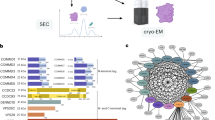Abstract.
COMM Domain-containing or COMMD proteins are a recently discovered group of factors defined by the presence of a unique motif in their extreme carboxy termini (Copper metabolism MURR1, or COMM domain). This protein family is comprised of ten members which are widely conserved throughout evolution and share certain functional properties. At the present time, a number of seemingly discrete functions have been ascribed to these factors. These include the regulation of such events as the activity of the transcription factor NF-κB, copper homeostasis, the function of the epithelial sodium channel, and cell proliferation. A unifying mechanism that would explain all these events is lacking at the moment, but recent studies suggest that regulation of the ubiquitin pathway may be the basis of many of the functions of the COMMD protein family.
Similar content being viewed by others
Author information
Authors and Affiliations
Corresponding author
Additional information
Received 13 February 2007; received after revision 27 March 2007; accepted 24 April 2007
Rights and permissions
About this article
Cite this article
Maine, G.N., Burstein, E. COMMD proteins: COMMing to the scene. Cell. Mol. Life Sci. 64, 1997–2005 (2007). https://doi.org/10.1007/s00018-007-7078-y
Published:
Issue Date:
DOI: https://doi.org/10.1007/s00018-007-7078-y




